![]()
![]()
![]()
Use LEFT and RIGHT arrow keys to navigate between flashcards;
Use UP and DOWN arrow keys to flip the card;
H to show hint;
A reads text to speech;
151 Cards in this Set
- Front
- Back
|
Why is there a relief valve that dumps refrigerant back into the low side liquid receiver? |
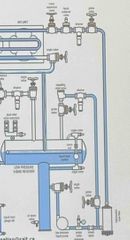
It is for removing excess pressure from the pump feeding all liquid overfeed evaporators |
|
|
16-27% mixture of air to ammonia? |
Explosive |
|
|
What is a surge reciever? |
One pipe In = out |
|
|
How is ammonia hydroxide created? |
When ammonia interacts with water. It is caustic it will burn your lungs. |
|
|
If you activate an eyewash station in a mechanical room you will active a flow switch and and an alarm |
True. |
|
|
575 btu/lb latent heat of evaporation? What is rating for |
Ammonia (NH3)
It has a low global warming potential B2 |
|
|
How big does it expand in its gaseous state? |
800% It is “light and fluffy” |
|
|
How much air do you need to dilute 1000 lbs of refrigerant to 25 ppm? |
14 times greater than the size of BC place
From worksafe BC |
|
|
Ammonia systems work with hardly any superheat? |
Superheat will add a lot of heat of compression because the lines of constant volume are so layed back |
|
|
What is the heat of rejection for ammonia btu/lb? |
800 btu/lb (Latent Heat of evapotation is 591 btu/lb and the heat of compression 209 HoC… typically) Luckily water is 970 latent heat of evaporation so evaporative towers work well. |
|
|
Why does the compressor for an ammonia system look big but the motor is small? |
The mass flow rate is still lower because the btu/lb of ammonia. The compressor is just big because ammonia is so big, light, and fluffy |
|
|
How good are cooling towers at rejecting heat. |
970 btu/lb |
|
|
If you freeze up the evaporative condenser and inlet line? |
Electrode on one, cathode on the other Call a welder |
|
|
Air over condenser is made out of? |
Steal |
|
|
Ammonia system out of compressor: 140F HoC (because of lines of constant volume) over condensing temperature (100F) So, 240-260F discharge temperature With bigger lifts you get higher head temperatures so what will you need? |
Water cooled heads Or Liquid injection into the suction line (“fogging the suction line”) |
|
|
What is the “back of the valve” temperature? |
70F warmer at the back of the valve than 6-8 inches down
330-350F mineral oil breakdown 380-400F poe oil breakdown 350-400F lip seals degrade and scrolls gall
Note: the INTERNAL TEMPERATURE OF THE SCROLL IS 50-75F HIGHER THAN THE TEMPERATURE OF THE DICHARGE LINE MEASURED 7 inches away from the compressor (6 inches) |
|
|
How many grains of moisture to a lb? |
7000 |
|
|
Do you need to know how to calculate the heat of expansion on a cold pipe (copper) that expands by 50TD and is…. 50ft long for the IP/TQ? |
Yes Expansion = (Length of pipe in inches)(max temp difference) (0.0000104)
600in x 50F x 0.0000104 = 0.312 inches |
|
|
How do they perform capacity control on a cooling tower? |
They will block of sections of air that would otherwise pass through the condenser (by using large blocking panels) Some systems will have a fan that recirculates the air from the outlet back into the inlet. |
|
|
Evaporative cooling is a constant enthalpy machine? |
If you look on a psychometric chart the evaporative cooler will follow that line. Relative humidity goes up and sensible goes down.
(Most water will not reach the bottom) |
|
|
Oil in an ammonia system is heavier than oil so it gets stuck. How do you remove the oil? |
Needs to be drained from the drop leg, dead mans valve, LOTO on valves, face shield, hazmat mask, Usually 2 man operation, Spring driven to closed. Flooded evaporator and drop leg underneath it. The drop leg is not insulated. You can see how full the drum is by seeing the frost line. As it fills with oil the frost line will go up. Refrigerant will boil off inside of the drop leg and head towards the surge drum as a gas (because the drop leg is not insulated). A and B open, C and D closed Isolate A, leave B open, residual vapor leaves out of A (outgas, no external heat), close B, Open C and then actuate the dead mans valve (D). (1) record how much oil is removed Return valves to normal position. A and B open, C and D closed When you close C make sure there is no oil trapped between C and D (2) put clean oil back in system
|
|
|
What are the codes about the sensors for class T mechanical rooms? |
(1)Refrigerant detector is visible outside of room (2)25 ppm (low level) exhaust fan and mua and local alarm/siren (3)35-50 (Mid level) all low level plus alarm company (4)100-200 ppm (high alarm) all low and mid plus notify emergency services (5)If the monitor is put of service then the room is for all intents and purposes in high alarm (6)If the monitor registers a high then it must be recalibrated (7)Sensor must be 10 ft above floor |
|
|
Who is in charge of inspecting the B-52 ammonia specifications? |
ABSA is incharge of inspecting the B-52 |
|
|
What are the rules around mua and exhaust fan for an ammonia machinery room? |
Indirect fired MUA
0.5 cfm per square foot when machine room is occupied or machine is running
Or
Alarm condition = 15 air changes per hour (total air volume of room)
(So we have a low speed and a high speed for the MUA)
Mua is piped for cross ventilation
Air inlets are at location least likely to accumulate
Exhaust vents are located in a location that is not an danger
The MUA cant serve anything but the ammonia room.
Emergency stop switch are inside and putside machine room. Will start but not start the MUA.
The ventilation will run till it is disconnected from power. The emergency stop switch located in and around the machinery room will turn off all rotating equipment and start the venting. |
|
|
How many times are you allowed to freeze up a chiller vessel before looking for work? |
0 times |
|
|
What is a class t machine room? |
One that contains ammonia |
|
|
TQ: What is an “emergency stop valve”? |
It will vent all the ammonia to air.
It vents the refrigerant on the low side vapor (sometimes the high side vapor) Diffuser on vent stack to prevent rain. |
|
|
Deluge tank has 8lbs of water to 1 lb of ammonia? |
True. Deluge tank can never freeze |
|
|
What does a class t machinery room loom like? |
(1) 1 exit that goes outside (with crash bar) (2) Exits go to a vestibule (mud room) (3) Vestibule is tight tight (4) vestibule has 1 hour fire protection (5) No heat over 800F in machinery room (6) No flame in machine room (7) Air ducts are tight and dont serve machine room (8) Pilot controls are outside the machine room (shut off all rotating equipment except mua and exhaust fan) (9) Relief lines are painted red (10) Ammonia pipes are orange (11) Emergency stop valve and emergency stop switch is outside building 7ft about grade |
|
|
What is wiring drawing? |
Erodes the valve seat Caused by refrigerant flashing |
|
|
Centrifugal pump had a vacuum in the center of the pump that can cause? |
Cavitation |
|
|
How do you adjust a hand expansion valve? |
Balance point for evap is achieved when you have a perfect td across the coil Too much superheat = too little refrigerant = low TD Perfect superheat= perfect amount of refrigerant= perfect TD No superheat = too much refrigerant= low TD |
|
|
Oil seperator on discharge has a check valve? |
True |
|
|
Oil seperator on discharge has a check valve? |
True |
|
|
Reciever can hold 100% of the charge? T/F? |
T, it can also hold 90% at 90F |
|
|
What is an EPR used for on a ammonia DX evaporator? |
(1) maintain suction pressure in evaporator (ORI) (2) used for defrost |
|
|
Why do multiple compressors pull off the top of a shared suction line? |
To limit liquid return Dry suction line is slopped away from direction of flow. 1/2” per 10 ft 1” per 20 ft No oil return for ammonia |
|
|
Gravity flooded evaporators use convection? |
True, a flooded Evap has very little superheat |
|
|
A surge drum is above the high side receiver. What does it do? |
Ensures no liquid returns to the compressor. The float tree attached to the high side receiver and will stop the prime mover if a high level is level is detected. Float tree is a sensor that monitors the level in the high side reciever. |
|
|
A surge drum is above the high side receiver. What does it do? |
Ensures no liquid returns to the compressor. The float tree attached to the high side receiver and will stop the prime mover if a high level is level is detected. Float tree is a sensor that monitors the level in the high side reciever. |
|
|
Reverse return system? |
A type of piping system where there are many lines under the rink and the pipe that is first fed is the pipe that is last out. |
|
|
A surge drum is above the high side receiver. What does it do? |
Ensures no liquid returns to the compressor. The float tree attached to the high side receiver and will stop the prime mover if a high level is level is detected. Float tree is a sensor that monitors the level in the high side reciever. |
|
|
Reverse return system? |

A type of piping system where there are many lines under the rink and the pipe that is first fed is the pipe that is last out.
Reverse return ensures every pass is the same length= same resistance= same flow |
|
|
A surge drum is above the high side receiver. What does it do? |
Ensures no liquid returns to the compressor. The float tree attached to the high side receiver and will stop the prime mover if a high level is level is detected. Float tree is a sensor that monitors the level in the high side reciever. |
|
|
Reverse return system? |
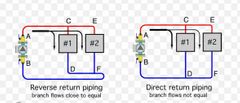
A type of piping system where there are many lines under the rink and the pipe that is first fed is the pipe that is last out.
Reverse return ensures every pass is the same length= same resistance= same flow |
|
|
What happened to the zamboni operator? |
They say he will resurface eventually. |
|
|
The pump in an arena pumps towards? |
The floor The largest pressure drop
The expansion tank is the before the pump at the point of no pressure change. We dont want a pressure change at the pump so it cant cavitate |
|
|
When will a pump cavitate? Net positive suction head… |
Net positive suction head actual is less than Net positive suction required
NPS Actual is less than NPS required |
|
|
The brine loop that goes under the arena floor with a pump that is pumping into the largest pressure drop the tubes under the ice ….with reverse return….. has an expansion tank on the inlet of the pump….. The expansion tank is…. |
Open to atmosphere Made out of plastic (air + brine + plastic = good) Hole in chiller will vent out the brine and out of the open to atmosphere expansion tank |
|
|
Advantage of a Gravity Fed Brine Chiller? |
(1) Lowers the required charge. 700-750 to 150 lbs
U turn evaporator fills up plates cold refrigerant in the bottom, warm brine counter flow, warm refrigerant rises and vapor is separated out, expansion valve adds more refrigerant
(2) Less refrigerant = Less dangerous
NOTE: this heat exchanger evaporator will need a dry condenser or an indirect cooling tower. |
|
|
What is the purpose of EPR on a ammonia flooded system? |
(1)Epr modulates evap pressure (2) Provide isolation for defrost |
|
|
What is the main purpose of a double drop txv |
Double drop txv valve is there to limit wire drawing on valve seat |
|
|
What is the lowest set point for a room served by a ammonia dx coil |
Limited to 10F refrigerated space temperature for a room served by a DX evaporator |
|
|
What does a gear pump not have that a centrifugal pump have? |
No pressure drop in the eye |
|
|
Cogen plant pressure? |
425 psi |
|
|
Float tree low low switch? Low switch opens? High switch activated? |
Low Low switch turns off Circulation pump (doesn’t like to run dry) Low turns on solenoid allowing refrigerant into evaporator (tube and barrel) High turns off solenoid stopping refrigerant into evaporator (tube and barrel) High high turns off prime mover. You dont want refrigerant entering the compressor. Note: after the solenoid there may be a restrictor to limit the pressure entering the evaporator. |
|
|
How does a liquid overfeed system operate? |
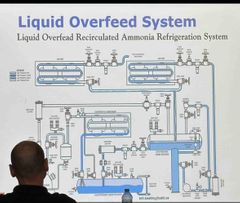
Back (Definition) |
|
|
What comes after the oil separator? |
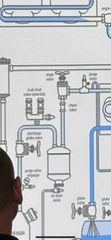
Check valve, then angle valve, then purge valve. |
|
|
Where is the purge valve on liquid over feed? |
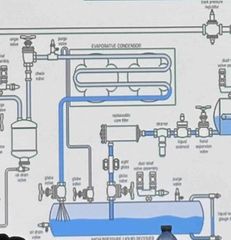
At the top of the condenser |
|
|
What kind of liquid reciver is on a constant liquid overfeed? |
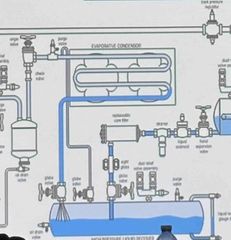
One coming in and another one coming out is a flow through… the disadvange is there is some dead charge inside of it
If the reciever only has pipe in and uses the same pipe for refrigerant out. It is a surge receiver. It will limit excess refrigerant in the system. |
|
|
You wont see (liquid line dryer) dryers on an ammonia system but you will see…. |
Strainers before ANY solenoids and HAND EXPANSION VALVE |
|
|
Why is there a relief valve that dumps refrigerant back into the low side liquid receiver? |
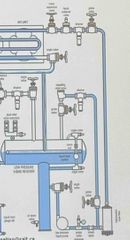
It is for removing excess pressure from the pump feeding all liquid overfeed evaporators |
|
|
If you change prime movers or evaporators in an old system that was grand fathered in….what will the owners have to do to “that type of machine room”? |
Come up to code B-52. (Spend the money.
Ventilation? Leak monitor? Vestible? Seal ducting? Add fire proofing? |
|
|
Single dump Recirculating system with pumper drums? How does it work? Quiz question: What does the single pumper drum pump into? |
Single dump TLDR: They use high side pressure to move low side pressure to the “high side” (controlled pressure receiver). If drum is empty, then open up some valves to allow in low side liquid in the bottom of the tank and fill it UP, then it closes those valves….drum is 80% full… Drum is 80% full so open up some valves and allow hot discharge gas to the vapour side (20% vapour) of the drum and open the valve to the “controlled pressure reciever” (which is lower in pressure than the refrigerant moving out of the drum via high side control system.) Liquid over feed system |
|
|
Double pumper dump Recirculating system with pumper drums? How does it work? Quiz question: What does the double pumper drum pump into? |
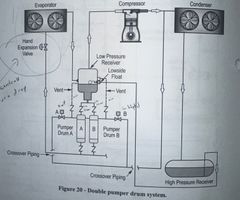
Drains into evaporator Liquid over feed system |
|
|
Single pumper drum and double pumper drum are forms of what? |
Liquid overfeed systems |
|
|
What is industrial ice? |
Brine ice that is shaved or blocks |
|
|
What are some other names for digital signaling? |
Digital, on off, discreet |
|
|
What is the ratio in a deluge tank? |
8:1 ratio |
|
|
What is the purpose of a surge drum? |
To prevent liquid flood back |
|
|
On a surge drum, saturated gas entering the bottom of the surge drum enters in two equidistant ports to ensure equal boiling in the evaporator. |
Yes. |
|
|
On a surge drum, saturated gas entering the bottom of the surge drum enters in two equidistant ports to ensure equal boiling in the evaporator. |
Yes. |
|
|
What is the slope on a refrigerant line. |
1/2” for 10 ft 1” for 20 ft |
|
|
On a surge drum, saturated gas entering the bottom of the surge drum enters in two equidistant ports to ensure equal boiling in the evaporator. |
Yes. |
|
|
What is the slope on a refrigerant line. |
1/2” for 10 ft 1” for 20 ft |
|
|
Why are there no liquid line driers on a ammonia system |
Ammonia is anhydrous |
|
|
If water enters the system it will turn into ammonia hydroxide and will interact with….. |
The oil. It gets white and frothy like you blew a head gasket. |
|
|
How do you do you find the compression ratio on a compound pump? |
Square root ( abs discharge / abs suction ) |
|
|
How do you do you find the compression ratio on a compound pump? |
Square root ( abs discharge / abs suction ) |
|
|
Single pumper drum goes into controlled pressure reciever. Where does the double pumper drum pump into? |
The evaporator. When one is draining the other is filling. |
|
|
The oil in the drop leg accumulates below the evaporator. How do you empty the oil sump? |
ABCD DCBA |
|
|
What is the most common tx valve for an ammonia system? |
Double pressure drop txv to prevent wire draw. |
|
|
On an oil accumulator below the evaporator on a ammonia system…. The frost shows up where on the accumulator? |
On the top of the drum showing where the refrigerant/oil line is.
Ex: if the oil accumulator has 25% frost on the top section of the drum then it is 75% full of oil. |
|
|
Which compressor in a compound compressor setup is considered the booster compressor? (Bonus: which one is the screw compressor if there is one!) |
The first stage compressor 5psi (low) -> 25 psi (intermediate) -> 125psi Put the units is absolute for the total compression ratio!!!
Bonus points: screw compressor will most likely be the booster compressor because recips dont like vaccums |
|
|
The closed intercooler is called a closed intercooler because…. |
The refrigerant passing through the intercooler is HIGH STAGE refrigerant and goes on to feed evaps as a super sub cooled liquid. |
|
|
The open intercooler is called an open intercooler because…. |
The refrigerant that passes on to the evaps is intermediate stage refrigerant that is a 99% saturated liquid. We use the subcooled high stage liquid dropped down to interstage pressures to desuperheat the 2nd stage suction gas but the intermediate stage liquid is then sent on to the system for use in evaporators. |
|
|
The compressor follows the lines of constant entropy. How do those lines look with ammonia? |
With more and more superheat the lines go flatter and flatter. Adding to my Heat of Compression. Liquid injection or head cooling |
|
|
With an open intercooler how is the NRE increased? |
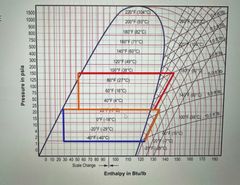
Because you are only pulling saturated liquid you are moving further left on the curve. |
|
|
How do you convert 11.8” Hg to psia? |
=14.7 psi -(11.8/2.04) = 8.92 psi |
|
|
Where is the rink sensor? TQ: What do the chairs sit on? |
At the tip of the goalie crease The pipe sits on chairs, the chairs sit on sleepers. |
|
|
There is an expansion joint around the outside of the concrete slab is typically about… thick? (BONUS: where is the vapour barrier?) |
An inch Its on the heat side. Aka the sand underneath the rink above the sand |
|
|
For an ice rink, how do they heat up the brine that heats up the floor underneath the ice slab? |
They use the discharge gas superheat to keep the floor above freezing. |
|
|
What is the purpose of the heat floor at an ice rink? |
Prevent frost heave |
|
|
At an ice rink why is there more tubing near the edges of the rinks under the boards? |
Because thats where heat is going to try and enter the system |
|
|
At an ice rink why is there more tubing near the edges of the rinks under the boards? |
Because thats where heat is going to try and enter the system |
|
|
When you first start up a compressor what does the operator need to do? |
Throttle the suction valve to limit the amp draw on the compressor. On start up there is a massive load on the system which means the gas returning will be very dense and very fluffy so the mass flow through the compressor will be very high, so the amps will be high because the compressor is doing a lot of work. |
|
|
When they put on the header clamps how do they orientate the pipe clamp heads? |
One on each side of the pipe to ensure a better seal. |
|
|
At an ice rink how often do they check on the headers for the brine circuit? |
Annually |
|
|
When does mineral oil breakdown occur? |
330-350F mineral oil breakdown 380-400F poe oil breakdown 350-400F lip seals degrade and scrolls gall Note: the INTERNAL TEMPERATURE OF THE SCROLL IS 50-75F HIGHER THAN THE TEMPERATURE OF THE DICHARGE LINE MEASURED 7 inches away from the compressor (6 inches) So 250F is bad |
|
|
Do you need to know the following for the IP Pipe sizing Temp conversion (C x1.8)+32 Crane signaling Ladder sizing Temperature penalty Refrigerant weight in lineset calculation |
Pipe sizing Temp conversion Crane signaling Ladder sizing
Temperature penalty Refrigerant weight in lineset calculation |
|
|
What temperature donthey run the ice at? Pro, amateur, figure skating, curling |
21F pro hockey 22-23 amateur 24F figure skating
The softer ice allows more traction. The little guys can get their edges in.
25-26 curling |
|
|
Secondary refrigerant forma skating rink temperatures? |
6-10F lower that rink set point |
|
|
How does a thermosyphon work? |
It used a heat exchanger to cool the oil. The mixing valve fails to bypass the heat exchanger because the oil in the heat exchanger might be too thick.
*the oil and refrigerant dont use cross flow to maximize cooling. |
|
|
Which way do three way valves fail? Around the corner? |
Yes, when the valve fail. |
|
|
Need oil pressure to make compression Need compression to make oil pressure How is this catch-22 over come? |
The compressor will have a check valve on the outlet oil separator. This actuated check valve will hold back oil till there is oil pressure on the back of valve. |
|
|
Need oil pressure to make compression Need compression to make oil pressure How is this catch-22 over come? |
The compressor will have a check valve on the outlet oil separator. This actuated check valve will hold back oil till there is oil pressure on the back of valve. |
|
|
Coalescing oil seperator removes….% of the oil? |
95% |
|
|
How do you unload a screw compressor? |
Slide valve |
|
|
Is the male or female the driver? |
The male is the driver, the female runs at a lower RPM |
|
|
On larger systems they will start up the system with oil pump and then just run off differential pressure once the system stabilizes. What is this pump called? |
Jet pump, York |
|
|
When a service port is not in use it is plugged on what type of system? |
Ammonia |
|
|
What is a condenser limit operation? |
Compressor will unload if the condenser pressure is too high. It will unload and run at a reduced capacity rather than trip on high pressure. |
|
|
What is a basket float? |
A high side float Critically charged |
|
|
If ammonia is hydroscopically trapped in liquid form how much will the pressure increase if the refrigerant goes from -10F to 10F? |
20 F degrees 1F = 100 psi
2000 psi |
|
|
If ammonia is hydroscopically trapped in liquid form how much will the pressure increase if the refrigerant goes from -10F to 10F? |
20 F degrees 1F = 100 psi
2000 psi |
|
|
Liquid lines must be schedule… |
80 |
|
|
If ammonia is hydroscopically trapped in liquid form how much will the pressure increase if the refrigerant goes from -10F to 10F? |
20 F degrees 1F = 100 psi
2000 psi |
|
|
Liquid lines must be schedule… |
80 |
|
|
Liquid lines 2 to 6 inches must be at least schedule… |
Schedule 40 |
|
|
If ammonia is hydroscopically trapped in liquid form how much will the pressure increase if the refrigerant goes from -10F to 10F? |
20 F degrees 1F = 100 psi
2000 psi |
|
|
Liquid lines must be schedule… |
Schedule 80
• 1. Liquid lines 1.5 inches and smaller shall be not less than Schedule 80 carbon steel pipe. •You may see this referred to as pipe size under 2" •2. Liquid lines 2 through 6 inches shall be not less than Schedule 40 carbon steel pipe. 3. Liquid lines 8 through 12 inches shall be not less than Schedule 20 carbon steel pipe. • 4. Vapor lines 6 inches and smaller shall be not less than Schedule 40 carbon steel pipe. •5. Vapor lines 8 through 12 inches shall be not less than Schedule 20 carbon steel pipe. •6. Vapor lines 14 inches and larger shall be not less than Schedule 10 carbon steel pipe. |
|
|
Liquid lines 2 to 6 inches must be at least schedule… |
Schedule 40
• 1. Liquid lines 1.5 inches and smaller shall be not less than Schedule 80 carbon steel pipe. •You may see this referred to as pipe size under 2" •2. Liquid lines 2 through 6 inches shall be not less than Schedule 40 carbon steel pipe. 3. Liquid lines 8 through 12 inches shall be not less than Schedule 20 carbon steel pipe. • 4. Vapor lines 6 inches and smaller shall be not less than Schedule 40 carbon steel pipe. •5. Vapor lines 8 through 12 inches shall be not less than Schedule 20 carbon steel pipe. •6. Vapor lines 14 inches and larger shall be not less than Schedule 10 carbon steel pipe. |
|
|
Liquid lines 8 to 12 inches diameter shall not be less than schedule… |
Schedule 20
• 1. Liquid lines 1.5 inches and smaller shall be not less than Schedule 80 carbon steel pipe. •You may see this referred to as pipe size under 2" •2. Liquid lines 2 through 6 inches shall be not less than Schedule 40 carbon steel pipe. 3. Liquid lines 8 through 12 inches shall be not less than Schedule 20 carbon steel pipe. • 4. Vapor lines 6 inches and smaller shall be not less than Schedule 40 carbon steel pipe. •5. Vapor lines 8 through 12 inches shall be not less than Schedule 20 carbon steel pipe. •6. Vapor lines 14 inches and larger shall be not less than Schedule 10 carbon steel pipe. |
|
|
Why are thicker schedules used on smaller pipe diameters?
Its not to do with pressure. |
It has to do with resistance to vibration and breaking |
|
|
If its vapour….schedules… Less than 6 And 6- 12 inches And 14 and bigger |
Its schedule 40 |
|
|
How many hangers do you need on a ammonia refrigeration system? Ex Corner then 100 ft and then another corner? |
Hangers must be within 2ft of a corner and 10 ft between thereafter until another corner
2ft hanger (because of corner) 12ft, 22ft,32ft,42ft, 52ft, 62ft,72ft,82ft,92ft, 98ft hanger (because of corner) = 11 hangers |
|
|
How do they label ammonia pipes? 1,2,3,4,5? |

1= pipe identity 2= (liquid), (vapour) or (liquid and vapour) 3= ammonia black writing on orange background 4= low or high 5= direction of flow |
|
|
How do they label ammonia pipes? 1,2,3,4,5? |
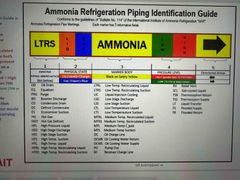
1= pipe identity 2= (liquid), (vapour) or (liquid and vapour) 3= ammonia black writing on orange background 4= low or high 5= direction of flow |
|
|
What size of threaded rod? |
3/8 threaded rod |
|
|
How do they label ammonia pipes? 1,2,3,4,5? |
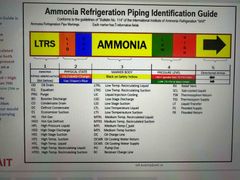
1= pipe identity 2= (liquid), (vapour) or (liquid and vapour) 3= ammonia black writing on orange background 4= low or high 5= direction of flow |
|
|
What size of threaded rod? |
3/8 threaded rod |
|
|
How are ammonia hangers attached to the ceiling? |
Directly to building structure |
|
|
How do they label ammonia pipes? 1,2,3,4,5? |
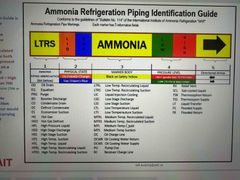
1= pipe identity 2= (liquid), (vapour) or (liquid and vapour) 3= ammonia black writing on orange background 4= low or high 5= direction of flow |
|
|
What size of threaded rod? |
3/8 threaded rod |
|
|
How are ammonia hangers attached to the ceiling? |
Directly to building structure |
|
|
How are they 3/8 threaded rod attached to the building? |
Beam clamps |
|
|
How do they label ammonia pipes? 1,2,3,4,5? |
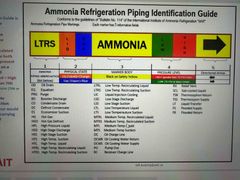
1= pipe identity 2= (liquid), (vapour) or (liquid and vapour) 3= ammonia black writing on orange background 4= low or high 5= direction of flow |
|
|
What size of threaded rod? |
3/8 threaded rod |
|
|
How are ammonia hangers attached to the ceiling? |
Directly to building structure |
|
|
How are they 3/8 threaded rod attached to the building? |
Beam clamps |
|
|
Pipe hangers are what style? |
Trapeze type Aka two threaded rod with a piece of unistrut across |
|
|
What is the IDLH of ammonia? |
The IDLH (Immediately Dangerous to Life or Health) concentration for ammonia is typically around 300 parts per million (ppm). Exposure to concentrations above this level can result in serious health effects or even death in a short period of time. |
|
|
What is the TLV for ammonia? |
TLV, Threshold Limit Value, which represents the concentration of a substance to which it is believed that nearly all workers may be repeatedly exposed day after day without adverse effects. The TLV for ammonia is typically set at 25 parts per million (ppm) for an 8-hour time-weighted average (TWA) exposure. |
|
|
What is the STEL for ammonia? |
The value between 25 ppm and 300 ppm for ammonia exposure would typically fall into the STEL (Short-Term Exposure Limit) range. STEL is the concentration to which workers can be exposed continuously for a short period, usually 15 minutes, without suffering from irritation, chronic or irreversible tissue damage, or narcosis. For ammonia, the STEL is often around 35 ppm. |
|
|
What is STEL? What is TLV/TWA? What is IDLH? |
• TLV/TWA • Threshold Limit Value • Time Weighted Average • TWA is Time Weighted for an 8 hour work day and a 40 hour work week • STEL/ST • Short Term Exposure Limit • STEL is a 15 minute exposure period • Short Term • IDLH • Immediately Dangerous to Life and Health From B52 MRC
Escape within 30 minutes without long term/ irreversible damage |
|
|
What level is fatal in a few breaths for ammonia? |
1700-2000 ppm |
|
|
What is the main difference between gravity flooded evaporators and Liquid overfeed? |
Gravity flooded does not use any pumps. |
|
|
What is necessary for liquid overfeed? |
A low temperature reciever and a pump.
The most common recirculation methods are: • pumped liquid overfeed, • constant pressure liquid overfeed and • double pumper drum. |
|
|
What is the name of a receiver that has an inlet pipe and an outlet pipe. |
Flow through |
|
|
-Which valve is has the most restriction? First year question.
-404a vs ammonia specific volume vs density
-what is a self alarming refrigerant?
- booster is ________stage
-where is the temp sensor in the arena?
Open drive is for _______capacity
What is Litmus and sulfur good for? |
Yep |
|
|
25,35,300 ppm? |
TWA/TLA 8 hours Stel 15 min IDLH 30 min |

